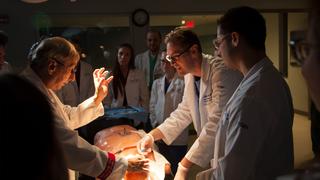Agreement Grants Students Access to State-of-the-Art Simulation and Skills Lab Spaces at PCOM
The multiyear agreement between Saint Joseph’s and Philadelphia College of Osteopathic Medicine is effective fall of 2025.
 Photo courtesy of PCOM
Photo courtesy of PCOM
Students applying to Saint Joseph’s University’s new Bachelor of Science in Nursing program in Philadelphia will now have access to an 11,000-square-foot, state-of-the-art simulation and skills lab space at Philadelphia College of Osteopathic Medicine (PCOM). The multiyear agreement between the two institutions is effective fall of 2025.
Located just over a mile away from Saint Joseph’s Hawk Hill campus, the Dr. Michael and Wendy Saltzburg Clinical Learning & Assessment Center features 15 patient rooms, four simulator training rooms, an operating room, ER/trauma bay, a med-surg suite, and a variety of high-fidelity robotic simulators, virtual simulators and task trainers.
“We are very fortunate that the quality of the facility and PCOM’s philosophy of simulation match that of Saint Joseph’s,” says Melissa Snyder, DEd, FNP, CNE, dean of the School of Nursing and Allied Health. “Simulation is an opportunity for students to practice both skills and clinical decision-making in an environment that’s supportive of the learning process and minimizes risk and safety issues.”
In fact, all clinical courses within Saint Joseph’s BSN curriculum incorporate skills- and simulation-based clinical experiences beginning in year two, with direct clinical-care experiences beginning in years three and four. In addition to guaranteed clinical placements with Penn Medicine, students at the University’s new Lancaster location have access to the Center for Excellence in Practice, and Philadelphia-area students will leverage PCOM’s facilities for skills laboratories and simulation activities.
We are very fortunate that the quality of the facility and PCOM’s philosophy of simulation match that of Saint Joseph’s.
Melissa Snyder, DEd, FNP, CNE
Dean of the School of Nursing and Allied HealthAs an osteopathic school of medicine that prioritizes whole person healthcare, PCOM is an ideal partner for the Jesuit institution that values cura personalis, or care for the whole person.
“That aligns really well with our philosophy,” says Snyder. “In both nursing and osteopathic medicine, as well as Jesuit education, we value respect, human dignity and the human experience. It’s about providing care for the whole patient, including the physical, emotional, psychological and spiritual aspects.”
In addition to gaining access to simulation spaces, students will benefit from skills labs for demonstration and didactic instruction, practice areas, open lab times to hone their skills, and classroom and debriefing spaces.
PCOM’s expert simulation team will support use of all equipment and simulation activities, working alongside Saint Joseph’s nursing faculty who will deliver all classroom instruction and student evaluations.
“We at PCOM pride ourselves on the caliber of our simulation learning environment so that students experience realistic settings to practice both their clinical and humanistic skills,” says Kenneth J. Veit, DO, provost and senior vice president of Academic Affairs at PCOM. “This agreement with Saint Joseph’s also helps expand the number of highly trained healthcare professionals entering the workforce.”
With Philadelphia College of Osteopathic Medicine and Saint Joseph’s being close City Avenue neighbors for 125 years, transportation to and from each location will be made possible through Saint Joseph’s existing shuttle loop.
The agreement goes beyond just physical spaces and simulation equipment; it opens up an opportunity for interdisciplinary education, too.
“With the shared space, we have the potential to have medical students and other healthcare professional students participate in interprofessional activities,” says Snyder. “It’s about finding ways to forge relationships and partnerships with programs over time and developing an interprofessional education program for years to come.”
Learn more about the simulation facilities.
